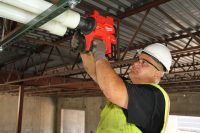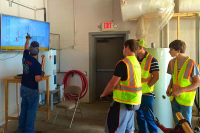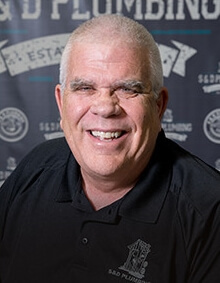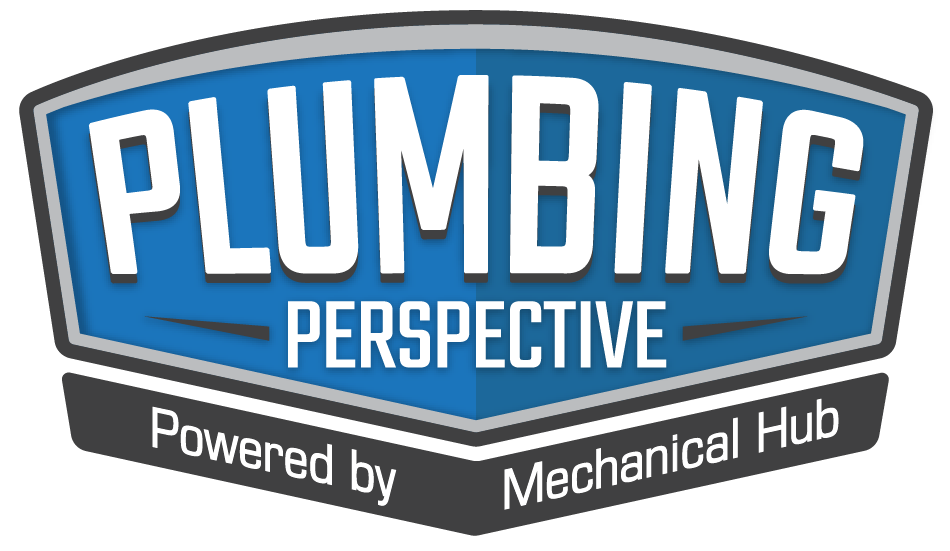Avalanche® Performance Tour Culminates on October 1 After four months and hundreds of stops across the country, the Avalanche Performance Tour has come to an end. Gerber will draw one lucky licensed plumber to win the grand prize of a Harley-Davidson Fat Bob motorcycle on October 1st at 10am in the Gerber booth at the Read more
Whats Next

Avalanche® Performance Tour Culminates on October 1
 After four months and hundreds of stops across the country, the Avalanche Performance Tour has come to an end. Gerber will draw one lucky licensed plumber to win the grand prize of a Harley-Davidson Fat Bob motorcycle on October 1st at 10am in the Gerber booth at the PHCC Connect show (Booth #508, winner need not be present to win)
After four months and hundreds of stops across the country, the Avalanche Performance Tour has come to an end. Gerber will draw one lucky licensed plumber to win the grand prize of a Harley-Davidson Fat Bob motorcycle on October 1st at 10am in the Gerber booth at the PHCC Connect show (Booth #508, winner need not be present to win)
The Avalanche Performance Tour featured promotional pricing opportunities and information regarding Gerber’s premier collection of Avalanche toilets. Known for its unparalleled performance levels, the Avalanche line has grown in popularity among plumbers due to its ease of installation and lack of callbacks.
To learn more about the Avalanche product line (and its popular 1.6 gpf model 21-818, which was recently named a Top Pick by a leading consumer magazine) visit www.gerberonline.com

A first in the industry, Uponor PEX pipe and ProPEX® ASTM F1960 expansion fittings will be
available in 2½” and 3″ sizes come November 2015, offering professionals the ability to
 A first in the industry, Uponor PEX pipe and ProPEX® ASTM F1960 expansion fittings will be
A first in the industry, Uponor PEX pipe and ProPEX® ASTM F1960 expansion fittings will be
available in 2½” and 3″ sizes come November 2015, offering professionals the ability to
design and install even more commercial piping systems with PEX. The pipe offering
includes Uponor AquaPEX® for potable-plumbing applications and Wirsbo hePEX™ oxygen-
barrier pipe for hydronic heating and cooling applications. To learn how larger-dimension
Uponor PEX can benefit your business, visit www.uponorpro.com/commercialpiping.

Twelve dead and 113 reported cases in an ongoing Legionnaires’ disease outbreak in New York City that dates back to July 10. The culprit? The sneaky SOB incubated in cooling towers in more than a dozen areas. I recall asking, “Why? How?” at a recent “Pathogen Risk Reduction by Design” seminar hosted by Tim Keane Read more
Twelve dead and 113 reported cases in an ongoing Legionnaires’ disease outbreak in New York City that dates back to July 10. The culprit? The sneaky SOB incubated in cooling towers in more than a dozen areas.
 I recall asking, “Why? How?” at a recent “Pathogen Risk Reduction by Design” seminar hosted by Tim Keane in regard to Legionella and plumbing systems design. Tim is a consulting engineer and owner of Legionella Risk Management, Inc. he is also an original voting member of ASHRAE 188 committee serving on that committee for over a decade. How does this happen and why are recent plumbing code changes making this problem more likely rather than less likely to occur?
I recall asking, “Why? How?” at a recent “Pathogen Risk Reduction by Design” seminar hosted by Tim Keane in regard to Legionella and plumbing systems design. Tim is a consulting engineer and owner of Legionella Risk Management, Inc. he is also an original voting member of ASHRAE 188 committee serving on that committee for over a decade. How does this happen and why are recent plumbing code changes making this problem more likely rather than less likely to occur?
Legionella, for example, can cause debilitating, even deadly, results in elderly people and those with compromised immune systems, and cases of Legionnaires’ disease outbreaks are seldom reported and perhaps not seen as a global problem—until recently. “Ninety percent or more of those that get Legionnaires’ disease have risk factors,” says Keane (Risk factors include: age, over 50; smokers, drinkers, diabetes, organ transplants, HIV, and others.)
As a result of the recent New York outbreak, according to the USA Today, New York City Mayor Bill de Blasio said the proposal would require all existing cooling towers to be registered with the city’s Department of Buildings. It also requires regular inspection, testing, cleaning and disinfection. He said the city had created a voluntary online registration database for cooling towers.
“It’s hard to believe that plumbing code changes over the past decade have made plumbing systems more likely to be at risk for Legionella colonization. Of course, what’s happening in NYC, this prolonged outbreak and now the Governor stepping in and telling the NYC mayor that the State and CDC will be getting involved, that’s really hard to believe. A public health crisis and public health officials in the largest city in the U.S. being told things need to change. Maybe we should get the Governor involved in plumbing code changes,” says Keane.
But back to how, and why. The seminar, sponsored by Viega, the company dedicated to water quality solutions through innovative plumbing components, brought to light the importance of plumbing design in overall pathogen risk reduction and control. “Twenty-five percent of Legionnaire’s Disease outbreaks occur within the first year of new construction or renovation,” says Keane.
Legionella can also cause a less-severe influenza-like illness known as Pontiac Fever. Most cases of legionellosis are the result of exposure to Legionella associated with building water systems, according to ASHRAE presidential member Tom Watson, chair of the committee that wrote the 188 Standard (see more below).
Transmission of Legionella is the aerosolization and aspiration from an environmental source into the lungs and because it is chlorine tolerant, it can survive the water treatment process and pass into the water distribution system. It grows in the water systems in the right conditions, i.e. water temperature, sediment and commensal microbes.
According to OSHA guidelines, water operations and proper controls prevent Legionella amplification; it is important to remember that any water system can be a source of disease if the water in it is subjected to conditions that promote growth of the organism. Remember, however, that the primary sources of exposure to contaminated water are heat rejection systems—cooling towers, fluid coolers, etc.—and hot water systems. Maintain domestic water heaters at 140 F and water delivered at the faucet at a minimum of 122 F.
ASHRAE’s guidelines are “conditions that are favorable for the amplification of legionellae growth include water temperatures of 77 F – 108 F, stagnation, scale and sediment, biofilms and the presence of amoebae.”
Variables such as water flow, distribution, velocity and temperature and play an important part for risk reduction. Risk factors such as water supply, building use and size, system design and hot water set-up all contribute to a safe and effective plumbing system. “Potable water is biggest culprit for Legionnaire’s Disease,” said Keane. There are more outbreaks of Legionnaires’ disease associated with potable water however potable water outbreaks tend to have few cases. Cooling tower outbreaks can be many times larger than a potable water outbreak.
Water Supply Risk Factors
• Supply Water Type — Surface water is a much higher risk than well water
• Type of Disinfectant — Chlorine, Monochloramine
• Disinfectant Residual at Building — Distance building from treatment plant; city flushing plan; occupancy rates in area
• Potential for Water Disruption — Renovation, Failure
Building Risk Factors
• Building Use — Expected occupancy rate, Seasonal occupancy fluctuation, phased construction
• Building Size — Increased risk for buildings with more than 10 stories
Plumbing System Design
• Hot and Cold Water Pipe Runs — Insulation, location of runs, distance between hot and cold pipes, volume of stored water, parallel vs. series
“Keep water away from excessive heat sources such as cold water capturing heat from mechanicals or underwater lighting systems that can raise water temps,” says Keane.
• Hot Water Return — Balancing, return pumps, monitoring
• Turnover (Water Aging) — Balancing, flow rate (ft./sec.), volume of water in branches, unused distal sites
Hot Water Heater Setup
• Outlet Temperature
• HW return
• Master Mixing Valve Installation
• Series or Parallel
• Monitoring
ASHRAE Standard 188 is essential for anyone involved in design, construction, installation, commissioning, operation, maintenance, and service of centralized building water systems and components. “ASHRAE 188 will make and immediate impact in the healthcare industry, ” says Keane.
Specific requirements in the standard include:
• Minimum Legionellosis risk management requirements for the design, construction, commissioning, operation, maintenance, repair, replacement and expansion of new and existing buildings and their associated (potable and non-potable) water systems and components.
• Establishment by building owners of a Program Team and (in turn) a Water Management Program for which they are responsible in order to comply with the standard.
• Provision of specific and detailed requirements for what Legionellosis control strategies must accomplish and how they are to be documented – but, does not provide (or place restrictions on) what specific strategies are to be used or applied.
“With 8,000 to 10,000 cases of Legionnaires’ Disease reported each year in the United States, and with more than 10% of those cases fatal, it is vital that we set requirements to manage risk of this bacteria,” said Watson.

Contractors consistently complain about the lack of skilled labor in the trades industry. Sam Dowdy, with S&D Plumbing in Taylor, Texas, is doing something about it. His labor of love, the Plumbing Pipeline Program (PPP), has captured the attention of many in the construction industry. https://youtu.be/iBRX74Y83aM An overview video of the Plumbing Pipeline Program Sam Read more
Contractors consistently complain about the lack of skilled labor in the trades industry. Sam Dowdy, with S&D Plumbing in Taylor, Texas, is doing something about it. His labor of love, the Plumbing Pipeline Program (PPP), has captured the attention of many in the construction industry.
https://youtu.be/iBRX74Y83aM
An overview video of the Plumbing Pipeline Program
Sam started S&D Plumbing, with his wife Rhonda, in 1980. His sons have since joined the business and the family operates the company together to provide quality service to the Greater Austin area. During the decades of operating S&D Plumbing, Sam identified a systematic problem with finding, hiring and retaining quality skilled employees. He created the Plumbing Pipeline Program (PPP) as a means to go into the community and recruit young people to the trades, much like colleges, universities and the military.

Sam Dowdy
In Texas, the average age of a Master Plumber is 58 years old. For every four plumbers that leave the industry, only one apprentice is filling their work boots. As contractors, we need these young people to consider plumbing a viable option for their future and the future of the trades.
Dowdy admits, “This program is all about youth, the youth in the community.” By targeting high school youth in his community, his program allows these students to apprentice at his plumbing company to learn basic skills of the trade. At orientation he proposes to the students that choosing the trades as your career path is, “a different way of doing things, without spending a lot of money.” Students are able to participate in the trade and gain an accurate concept of what it’s like to work for a professional plumbing company.
With the support of the PHCC of Texas, Sam created the Plumbing Pipeline Program to create awareness of the trades as a valuable and lucrative career option. The PHCC also helped to create an informative video about the Program (see above).
Dowdy hopes to “dispel the myth of the butt crack plumber.” He realizes that communication is the key to ensuring the longevity of the plumbing trade. By reaching out to Counselors, Educators and School Districts, Dowdy has created a pipeline for students to transition from high school, to a full-time apprenticeship upon graduation. At the same time, Dowdy has worked to address the problem with lacking skilled workers. He’s recruiting and training his workforce for the future.
For more information go to www.PlumbingPipelineProgram.com.
 Allie Perez is director of operations, Mr. Plumber / Mr. AC, San Antonio (http://www.mrplumbersa.com). Her interesting viewpoints on the trades can be found on her blog at http://www.mrplumbersa.com/blog. She also is founder of Texas Women in the Trades (TWIT). Visit texaswomenintrades.com.
Allie Perez is director of operations, Mr. Plumber / Mr. AC, San Antonio (http://www.mrplumbersa.com). Her interesting viewpoints on the trades can be found on her blog at http://www.mrplumbersa.com/blog. She also is founder of Texas Women in the Trades (TWIT). Visit texaswomenintrades.com.

https://youtu.be/-XEBr9lHdYU This video teaches you about the different copper tubes used for medical gas applications. With the help of his assistant, Ron Gumucio, Copper Development Association’s Piping Applications Specialist, Harold Moret, introduces the approved copper materials and installation methods for medical gas piping systems Read more
This video teaches you about the different copper tubes used for medical gas applications. With the help of his assistant, Ron Gumucio, Copper Development Association’s Piping Applications Specialist, Harold Moret, introduces the approved copper materials and installation methods for medical gas piping systems.
